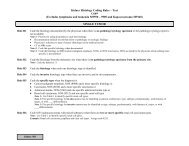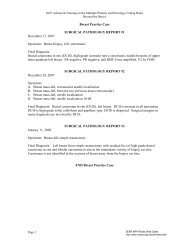Self Instructional Manual for Cancer Registrars - SEER - National ...
Self Instructional Manual for Cancer Registrars - SEER - National ...
Self Instructional Manual for Cancer Registrars - SEER - National ...
You also want an ePaper? Increase the reach of your titles
YUMPU automatically turns print PDFs into web optimized ePapers that Google loves.
Example E4 can be abstracted as follows:<br />
12/31/91 Ultrasound: Mass lesion, superior and posterior portion of left kidney,<br />
not cystic. Right kidney WNL.<br />
Comment:<br />
WNL means within normal limits.<br />
MAMMOGRAPHY:<br />
Mammography is a technique <strong>for</strong> the detection of breast cancer. In this procedure, several x-ray<br />
views are taken of one or both breasts and the radiographs are examined <strong>for</strong> the presence of a<br />
lesion. When a lesion is detected, the radiologist often can determine quite accurately whether<br />
it is malignant or benign. Mammography is important because very small, early cancers can be<br />
diagnosed with this technique be<strong>for</strong>e they are large enough to palpate. Mammograms of the<br />
opposite breast should be recorded as well as those of the involved breast. The findings of a<br />
mammographic examination will be reported on an x-ray report such as Example E5 shown on the<br />
next page. Abstract what you think is pertinent and then compare with the suggested abstraction<br />
on page 53.<br />
XERORADIOGRAPHY:<br />
Xeroradiography, a product of Xerox Corporation, has been known since 1950. The xerographic<br />
process is another way of doing mammographic examinations. Its merit is in its greater precision<br />
in outlining boundaries of masses and detecting fine calcification often seen in occult neoplasms.<br />
In xeroradiography, the x-rays are developed using the same image-producing process as the Xerox<br />
office copier machines. The xeroradiography machine can produce either a positive or negative<br />
picture on specially coated white paper that can be read in any light.<br />
Today, xeroradiography is used <strong>for</strong> x-rays of the skull, limbs (feet, arms, legs), and breast as well<br />
as <strong>for</strong> cervical spinal examination. Also, it can be used <strong>for</strong> locating <strong>for</strong>eign objects (wood, glass<br />
or metal splinters) in the eye or other parts of the body.<br />
49

















